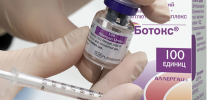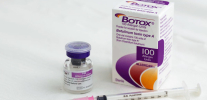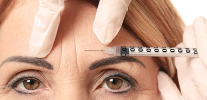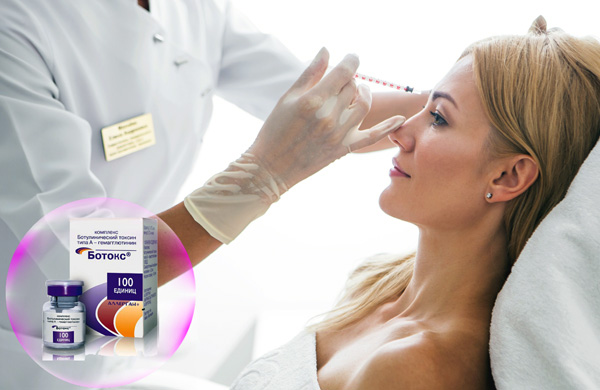
For all its advantages, botulinum therapy has a specific feature, which is sometimes considered a drawback: injections of botulinum toxin preparations should be repeated regularly, and they should be done as soon as the effect of the previous procedure is completed. Although such regular repetitions are considered the norm for almost all cosmetic procedures, regular Botox injections for some reason confuse some patients. There are many reasons for this: the toxin, which is sometimes feared, and the “horror stories” from the Internet about how someone “disfigured Botox with someone”, and the fear of far-fetched “dependence” on injections. Plus the financial component: Botox injections, although accessible to most patients, cannot be called cheap. Therefore, when planning your first procedure, it is useful to know how often you need, and most importantly, you can - inject Botox without harm to health, without damage to your wallet and with the desired cosmetic effect.
We must say right away that this frequency depends on many factors and can vary significantly among different people. It is influenced by age, lifestyle, individual characteristics of the body, the place of administration of the product and its type, diligence in observing the requirements of the cosmetologist and much more. It is not surprising that one person is enough to inject once a year, and another has to inject Botox every 3-4 months.
But the most important thing that worries many patients of cosmetology clinics: how does the body respond not to one-time, but to regular Botox injections? How often can it be pricked and is it worth it to start doing it? Let's find out these subtleties.
Why Botox injections have to be repeated regularly
The temporary, albeit quite long-lasting effect of Botox injections is explained by the fact that the removal of wrinkles during its use is not normal for the body at a particular age and the body is quite effective in combating this effect. Such a fight and restoration of the “normal” condition for the body (and an unwanted clinic for the client) of the skin with wrinkles and creases takes time, during which, in fact, wrinkles are absent, but after which they reappear.
How does this happen?
When a cosmetologist injects botulinum toxin into muscle fiber, the drug begins to diffuse (spread) along the fiber and go to its periphery. Here are the nerve synapses - the formation at the sites of contact of nerve cells and muscles. When a nerve impulse enters the cell, a cascade of chemical reactions occurs at the synapse, which ultimately leads to muscle contraction.
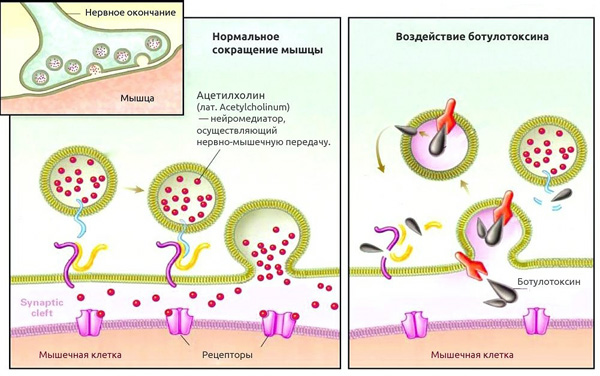
The mechanism of action of botulinum toxin on the muscle cell.
When this muscle contracts, it compresses the skin that tightens it and a wrinkle appears on it. When the muscle relaxes, the wrinkle disappears. If such a reduction occurs very often, in place of the wrinkle, a constantly noticeable strip appears on the skin. Such stripes are especially noticeable on the forehead, and in old age - around the lips, in the corners of the eyes and other places.
In different people, due to differences in the emotionality and elasticity of the skin, such permanent wrinkles may appear at different ages. For some, they form after 35–40 years, when the skin, due to age, becomes less elastic and elastic, while for others, constant “creases” become visible as early as 25–30 years.
If Botox enters the nerve synapse, it binds a certain protein here, which is necessary for one of the reactions of impulse transmission from the nerve to the muscle to occur. As a result, even when a nerve signal arrives, the muscle does not contract, the skin does not wrinkle and the wrinkle does not appear.At the place of already formed creases during additional procedures, the bands can either disappear completely, or become much less noticeable.

Botox actively fights wrinkles. Even if creases are formed on the face for a long time, then they become less noticeable.
On a note
This is how the toxic effect of botulinum toxin develops when it enters the digestive tract. From here it spreads with blood through the internal organs and also denervates vital muscles - the diaphragm, muscles of the digestive tract, and heart muscle. In severe poisoning, a person dies from suffocation or cardiac arrest. This option is excluded during the cosmetic administration of Botox, since an extremely small amount of toxin is injected into the muscles, which is immediately distributed in the target muscles. From here, it does not enter the bloodstream and does not reach the vital muscles, which means it cannot lead to poisoning.
This result is very attractive for a person who does not like wrinkles. But it is also abnormal for the body - for it, the inability of the muscle to respond to an impulse from a nerve is a problem, an analogue of the disease. And as soon as the impulse transmission is interrupted in a particular synapse, the mechanism of formation of a new duplicate synapse starts. As soon as it is fully formed and begins to function, the muscle begins to contract again in response to a signal from the nerve. And with it, the skin wrinkles again and wrinkles appear again.
On a note
It is a mistake to believe that botulinum toxin is "washed out" of the tissues or is somehow broken down by various substances in the body, because of which it ceases to act. In the synapse in which he fell, he persists for many years and virtually completely neutralizes it.
According to histological studies, such a compensatory mechanism starts almost immediately after the “sync” of a particular synapse. It doesn’t matter how many synapses and how many muscles have been deactivated - exactly the same number of their doubles starts to be created to restore the innervation of the muscles.
Consequently, Botox and its analogues after administration act for as long as the body "builds up" new neuromuscular contacts. Since nerve tissue is one of the most conservative in the body, normally this happens relatively slowly. Practice shows that after the introduction of botulinum toxin, eliminated wrinkles begin to appear again after a few months - from 3 to 9-12. Therefore, if you do not want to observe these wrinkles, you need to stab Botox precisely after that period of time through which they begin to appear again.
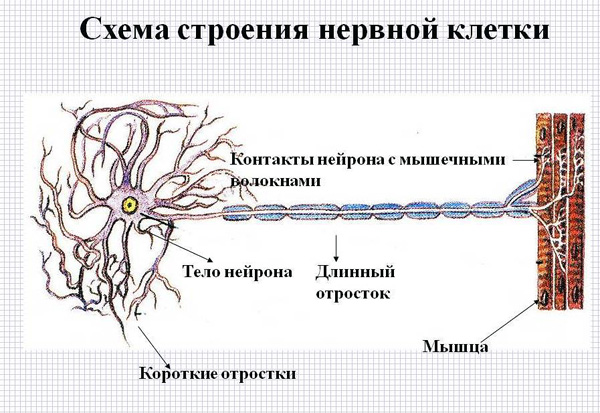
Nerve cells recover much more slowly compared to other body tissues (from 3 to 12 months). This property is just used for Botox injections.
What affects the duration of this effect of botulinum therapy in a particular person?
Botox effect completion speed
Even before the first injection, it is impossible to accurately predict how long the effect of non-e will last. It depends on many factors, the most significant of which are:
- Individual characteristics of the body - metabolic rate, reaction to the drug, structural features and work of individual muscles. For example, it is known that professional athletes are much more likely to experience cases of very rapid completion of the effect of Botox injections - in 2-3 months, which may be associated with very intensive tissue regeneration processes. In people with very expressive facial expressions, the effect of the drug introduced into the muscles of the face completes faster than in the less emotional ones, since they have higher activity of the muscles and their innervating neurons, due to which the restoration of innervation is faster;
- The specificity of the drug.It is known, for example, that the effect after the administration of Dysport (and its analogue of Azzalur) persists in most patients for 5-6 months, and the effect of Botox, Xeomin and their analogues lasts up to 9-12 months;
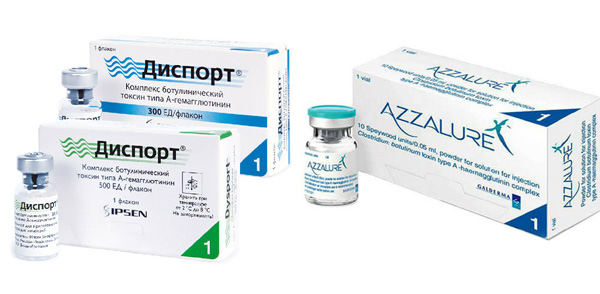
The effect of Dysport and Azzalur usually lasts no more than 6 months.
- The amount of the drug administered - in small doses, the drug can stop the effect of not all synapses and do not denervate all muscle fibers, but only part of them. This will be enough for the disappearance of wrinkles, but due to this, the restoration of the full contractile ability of the muscle will occur faster;
- The location of the injected muscle. So, wrinkles on the back of the nose and on the forehead are usually eliminated for a longer period than in the corners of the eyes and around the mouth;
- Specific defect to be repaired. It is well known that with the help of Botox and its analogues in cosmetology, they not only eliminate wrinkles, but also correct facial contours, smooth out the lumpy chin, and reduce the relief and “brutality” of individual muscles. Moreover, if Botox can eliminate a wrinkle on the forehead for six months or a year, then, for example, it can correct the relief of the “square” lower jaw for 2-3 years, and in some cases for the rest of its life without additional injections.
Also, individual sensitivity to botulinum toxin must be considered. For some people, the effect of its use is not observed at all (among them there may be those who have had botulism), for others, the effect is barely noticeable and passes extremely quickly - in a matter of weeks. Such cases are rare, according to the statistics of such insensitive people no more than 5%, but such a probability must be taken into account before the first procedure.

There is a category of people (about 5%) who are not affected by botulinum toxin. The effect of the procedure is either minimal or completely absent.
Finally, all these factors can overlap, and sometimes one person will have Dysport staying on his face longer than another would have a stronger Botox.
How often can and should I inject botulinum toxin preparations?
In the most general case, Botox can be injected as often as soon as a need arises.
Simply put, as soon as a person has wrinkles or other defects that have been eliminated after the previous botulinum treatment procedure, he can again be given injections.
On a note
Saying here that a person “needs” to inject Botox is incorrect. There is no urgent need for its cosmetological application - if the patient has wrinkles again, he can walk with them for an arbitrarily long time, and carry out the subsequent procedure when he wishes. You can talk about necessity when it is critically important for a person to prevent wrinkles or other defects from reappearing.
However, some restrictions exist.
For example, Botox should be pierced after the first procedure no earlier than two weeks, since such an additional injection is carried out in the same muscles as in the first procedure, if it did not give a full result. However, any cosmetic procedures, especially the invasive ones, after injections are allowed no earlier than after 10 days. Therefore, Botox can be injected into the same areas with an interval of at least 2 weeks.
If injections are planned to be carried out in different parts of the body, then the interval here in the absence of generalized side effects may be absent altogether. For example, if after injections in the forehead there is no allergy or flu-like syndrome, you can inject the drug into the neck, shoulders or legs the very next day.

If side effects on the administration of botulinum toxin are not manifested, then you can inject the drug into other problem areas the next day.
On a note
All of the above is true only for the cosmetic use of Botox.In medical practice, the frequency of its use in a particular patient is determined by the specific disease, its severity and the rate of recovery of symptoms after the procedure. In this case, only the doctor can decide how often the patient needs to inject Botox. It is important here that with medical indications regular botulinum therapy is necessary, while with cosmetic use it is carried out only at the request of the patient.
In general, if we are talking about injections of Botox and its analogues, then they need to be pricked approximately every 7-10 months. Dysport injections have to be repeated every 5-7 months.
Also, sometimes after the procedure, there is a need for Botox to “crush”, if for safety reasons the doctor first used too little amount of the drug and the effect was not shown in full. Such “piercing” can be carried out on days 12-14, and this interval is determined not so much by safety considerations as by the need to evaluate the full effect after the first procedure. About 10-12 days, this can be done: the effect of the drug is fully manifested and possible side effects of the drug, which can hide part of the result, disappear.
This moment is interesting: cosmetology practice shows that the longer a person regularly injects Botox, the longer the effect persists after each subsequent procedure, and the less often he needs to repeat these procedures. This is true for most (though not all) patients under the age of 50-60.
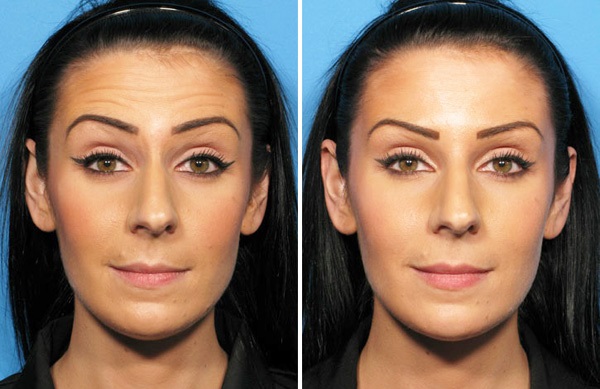
Practice shows that in most patients under the age of 50 the effect of repeated Botox injections becomes longer each time.
It is believed that such an increase in the duration of the effect is associated with regenerative processes in the skin. After the procedure, the muscle stops contracting for several months, in places of wrinkles the skin regains its smoothness, processes of regeneration of subcutaneous tissue occur in it, and the strict spatial structure of the arrangement of cells is restored. Additionally, the muscle itself loses volume during its inactivity, weakens. As a result, when its innervation is restored, it can no longer shrink and wrinkle the skin with the same strength, especially since the skin is no longer so “malleable” for wrinkling.
If at the same time the muscle is again immobilized at the first manifestations of its activity, it will not be able to permanently affect the skin to disrupt the structure of the intercellular matrix, will not lead to the appearance of visible defects on the surface of the skin.
This process will be enhanced by the fact that a person gradually weaned out to wrinkle those parts of the face or body where the muscles on which are weakened by Botox. Over time, these muscles completely cease to be involved in the process of facial contractions and even after the expiration of the botulinum toxin, they no longer contract by themselves and do not cause wrinkles.
Due to this, in people who inject Botox regularly, the intervals between procedures can increase up to 14-18 months, during which no wrinkles are visible at all.
It is clear that this effect is very individual. Someone's facial expressions can be very pronounced, someone's skin regenerates for a very long time. Also, in older people, wrinkles are formed even without muscle contraction due to thinning of the skin and loss of moisture.
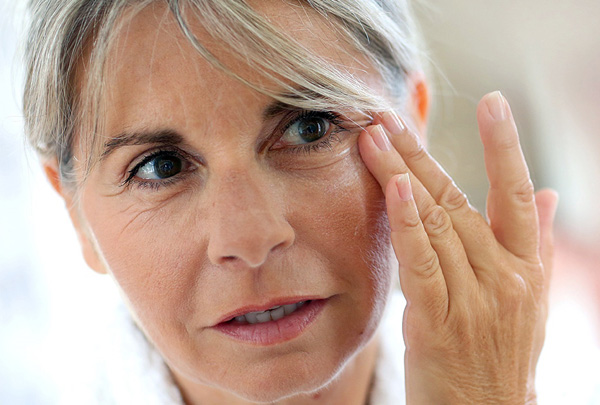
Due to age-related aging of the skin, in patients older than 50 years, wrinkles are formed without muscle work, therefore, the duration of the effect of botulinum toxin injections is usually reduced.
Nevertheless, at the age of 35-55 years, when getting rid of these defects is most relevant, for most people the regularity of botulinum toxin therapy provides an increase in the interval between the procedures themselves.
As a rule, in most patients, the intervals between procedures vary as follows:
- In the first 2-3 years they are injected every 8-9 months for Botox and every 6-7 months for Dysport;
- Then, over 2-3 years, the intervals gradually increase to 12-14 months for Botox and 9-10 months for Dysport;
- Then gradually the intervals reach 14-15 months for Botox and analogues, and 11-12 months for Dysport.
Perhaps in the future, procedures can be carried out even less often. But the data for patients who have been injecting the drug for so long (more than 8 years) are not enough for generalization today due to the relative youth of botulinum therapy itself.
Feedback
I don’t have very often botox injections. The first time I stabbed only in the forehead and between the eyebrows, for 4 months the effect was gone, I went to set again. The second time was longer - the action lasted 6 months, the next time it was delayed in the trip, came in 8 months, although there were no obvious creases. 8 months have already passed, everything, as soon as after the injection, will probably stretch for a year. Although I think it's better twice a year for a little bit than rarely and a lot. Despite the fact that the first time I was put in 20 units, and now they put only 12 with the same result. The cosmetologist told me so: the muscles weaken, they can no longer squeeze the forehead, frown, and even when the effect ends, they do not immediately lead to wrinkles. Therefore, frequent use is necessary only at first, then it will be necessary to prick less and less. Yes, if it is important to anyone: it’s Botox that I inject. Neither Dysport nor Relatox has ever set.
Angelica, Moscow
Another deviation from the standard scheme is relevant for the use of Botox for bruxism, for smoothing too strong, "square" lower jaw, healing of scars. In these cases, one or two procedures may be enough to eliminate the defect for life.
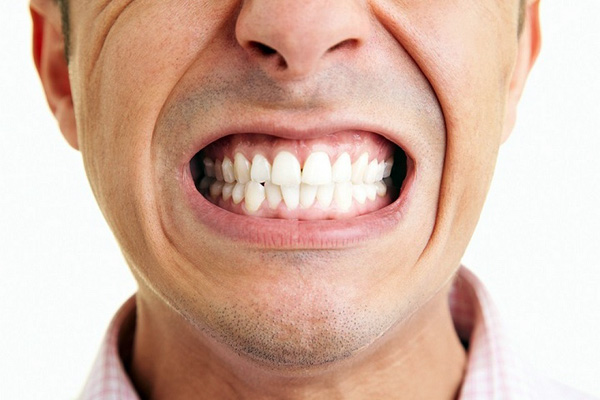
One or two Botox injections are enough to permanently get rid of bruxism - nightly grinding of teeth due to a spasm of the masticatory muscles.
For example, for people with too strong muscles of the lower jaw and, accordingly, the wide lower part of the face, it is enough to weaken this muscle with Botox once and then for several months to abandon the habits that led to such an increase in the lower jaw: chewing gum, plenty hard foods in the diet (dried fruits, meat with minimal heat treatment, nuts), constant smoking of cigars and gritting of matches with teeth. Without such physical exertion, the muscle weakens, loses part of its mass and volume, the lower jaw is smoothed. And when the activity of this muscle is restored, its volume does not increase anymore, because having abandoned the corresponding habits, the person no longer “trains” and does not “pump” it.
From these considerations it is clear that the earlier Botox starts to be injected, the less often it will have to be done. When injections begin at the first hint of wrinkles, the skin at the site of the creases does not thin out and maintains a normal structure. In this case, even after restoration of muscle innervation, the wrinkles themselves will appear more slowly, and their severity will be insignificant.
On the contrary, if you start injecting Botox very late, it will be very difficult to get rid of some particularly deep wrinkles, and they will be restored especially quickly.
Moreover, the age for the first injection is practically unlimited.
At what age can Botox or its analogues begin to be injected?
There is no lower age limit for the use of botulinum toxins. So, in medical practice, children with cerebral palsy, spasms, and some other pathologies Botox injected from 2-3 years old, and according to the recommendations of a doctor - sometimes from a year.
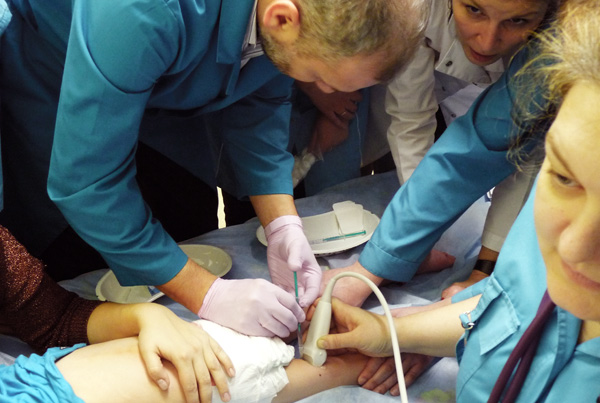
Botulinum therapy is used to treat cerebral palsy from a very young age.
In cosmetology practice, the need for botulinum toxin injections appears no earlier than 20-25 years. Moreover, at this age, only a few wrinkles appear - usually very emotional people with active facial expressions.If the need for wrinkle correction at this age appears, Botox can already be pricked.
Other defects may need to be eliminated even earlier - a gingival smile, asymmetry of the opening of the palpebral fissures, the lower jaw strengthened due to bruxism. To correct them, Botox can be pricked as early as 12-15 years.
It's important to know
The ethics of cosmetologists dictate certain rules for the use of Botox against cosmetic defects that do not interfere with the patient's normal life: only the patient must decide on the procedure. If for medical purposes children can and should be injected with drugs even when they cannot make such decisions due to age, then Botox can correct wrinkles or oval of the face only when the patient himself realizes the need. This allows you to avoid cases of exploitation of the child and his appearance in order to satisfy one or another ambition of the parents (for example, when people striving for success of heirs already in 5-6 years old try to "sculpt" models with ideal appearance from them).
How to prolong the effect of injections
There are no absolutely reliable and universal ways to prolong the effect of botulinum therapy, and at the same time reduce the frequency of procedures.
The most obvious way to guarantee a longer effect is to enter Botox, or its analogues - Xeomin, Mioblock, Relatox and others. Dysport, although it costs less, but also provides a less lasting effect.
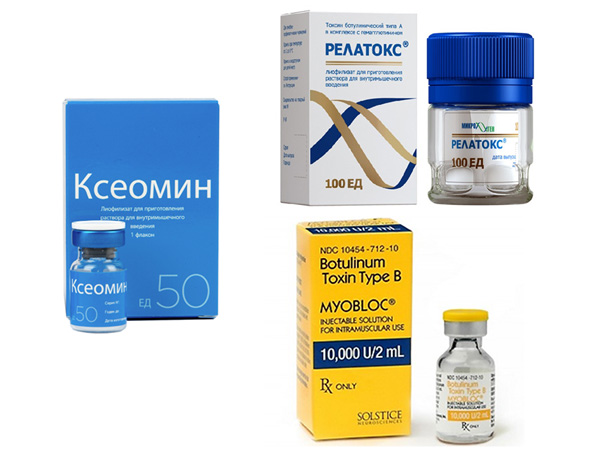
Botox analogs giving approximately the same duration of the result.
Before the procedure itself, it is advisable to inform the cosmetologist about the desire to fix the result for the longest possible time. To some extent, the doctor can increase the amount of the drug administered to extend its duration.
Another way, depending only on the patient, is to control your own emotions and contractions of the muscles that were denervated by Botox. In this case, even when the duration of the drug ends, without excessive muscle contraction, wrinkles may not appear and do not affect the skin condition for several months. And the greater such control, the longer Botox will not need to be injected again.
Finally, Botox can be extended by additional procedures. If, for example, fillers are introduced into the skin fractures within a few weeks after botulinum therapy, primarily based on hyaluronic acid, this will accelerate skin regeneration and slow down the repair of wrinkles after the completion of botulinum toxin. In some cases, this effect of the complex procedure is enough for 1-2 years.
Can a violation of the rehabilitation period shorten the duration of Botox?
At the same time, if after the Botox injections you violate the doctor’s instructions, the effect of the procedure may be completed earlier. This is due to the fact that some actions in the first days after injections can contribute to the diffusion of the drug into those muscles that were not planned to be processed by them. On the one hand, this increases the risk of side effects, since immobilization of unwanted muscles leads to unpredictable changes in facial expressions, on the other hand, the more the drug spreads to neighboring muscles, the less it affects the target fibers. Consequently, the effect is incomplete, fewer fibers are immobilized and muscle activity naturally recovers faster.
For example, Botox is injected around the eyes to combat crow's feet. In violation of the rules of the rehabilitation period, a day or two after the procedure, the patient goes to the sauna, warms his face and part of the drug diffuses into the muscles above the eyes. Because of this, eyebrows are raised and the face constantly expresses surprise, and the wrinkles themselves are restored after 4-5 months instead of the planned 9-10.
Various effects can lead to such effects: playing sports in the first few days after the procedure, visiting a bath or sauna, sun exposure, deep bending or sleeping in the first few hours after injections, taking certain medications.

In the first days after the procedures, it is necessary to limit physical activity, exposure to the sun, abandon thermal procedures.
A good example of this situation is athletes who, because of the tight training schedule, exercise begins during the first days after injections and the drug does not last long (this effect is also supplemented by a generally faster metabolism due to increased loads).
Are botulinum toxin shots harmful?
In the most general case, regular injections of botulinum toxins are as harmless as a once-in-life injection. Since the drug does not have a systemic effect on the body, it does not affect the general state of health in any way, and it can be pricked relatively often.
Nevertheless, it is necessary to take into account some of the consequences that may arise with the long-term use of botulinum toxins:
- In those places in which Botox is administered continuously, the muscles gradually lose their strength. Due to compensatory mechanisms, this can significantly affect facial expressions. Many people often see some kind of unnatural smile, calm or, conversely, irritated facial expressions, although there are apparently no noticeable defects. The more competent the cosmetologist who performs the procedures, the lower the risk of such consequences;
- Botulinum toxin can provoke the body’s immune response, which will manifest itself in the fact that over time, its effectiveness, on the contrary, will decrease - the immune system will simply more and more effectively neutralize it. This happens infrequently, but such an option is possible;
- Finally, the purely psychological aspect is important. Many people are so “addicted” to Botox that before each repeated procedure they begin to look for tiny wrinkles on the face, defects in the general contours, and they ask the doctor each time to inject the drug not only into already known zones, but also into new, completely different ones. This can lead to the fact that too many muscles will be denervated and facial expressions will be violated in general - the face will become either unnaturally smooth, as if covered with wax, or the person will completely lose the ability to express emotions (the so-called “doll face”).
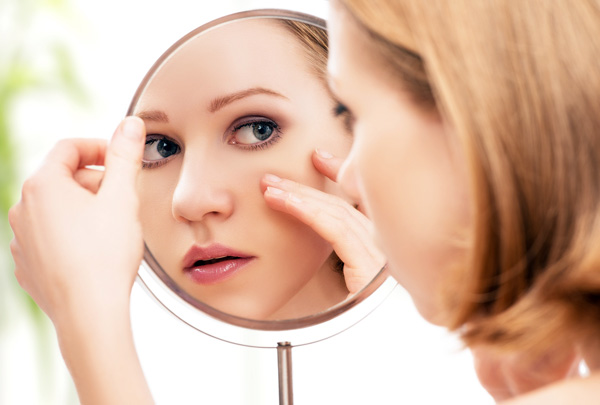
Sometimes a passion for Botox can lead to psychological disorders: a woman finds a physical disability where he is not.
In addition, many people develop psychological addiction to procedures. If they inject Botox for many years in a row, the delay or skipping of the next procedure causes them concern, they are worried that now they must immediately “get out” all carefully hidden defects.
Botox injections do not cause physical dependence. If the drug is injected irregularly, no sensations occur after the expiration of the interval that is usual for a person in an interval.
Similarly, botulinum toxin preparations do not cause such deformities that people like to scare each other on the Internet, showing pictures of “Botox victims”. If Botox itself is not counterfeit, then it does not swell lips or cheeks, eyes are not closed, skin is not rough. Moreover, Botox does not cause dementia, cancer or fistula.
All such horror stories are a figment of the imagination, the results of the use of counterfeit or illiterate indiscriminate use of fillers.
A few words about irregular injections
Similarly, irregular Botox injections are perfectly safe. It doesn’t matter if they are injected strictly once a year, or completely without a schedule, the result of injections, all other things being equal, will be the same.Except that if the interval is too long, during which the wrinkles reappear and are aggravated, they will have to be removed with a large amount of the drug, and sometimes with complex procedures, while with regular injections it will be necessary to stab approximately the same amount of the drug constantly. Simply put, if you miss the point, Botox alone will not work out wrinkles.
All this means that you can inject Botox as often as necessary to maintain the desired effect and how the patient can afford it. In some cases, individual restrictions are imposed on the frequency of the procedures due to specific side effects, the features of the defects to be fixed, but this cannot be foreseen in advance. Only a cosmetologist should evaluate all such situations, and he will develop an optimal injection program for the patient.
Useful video: when you can start injecting Botox
Why the effectiveness of botulinum therapy is reduced

